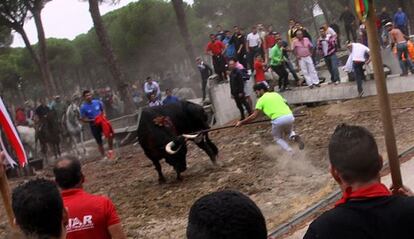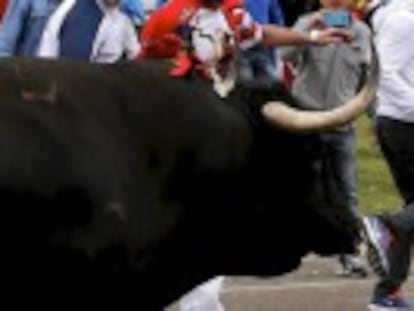Why the Toro de la Vega and bullfighting are worlds apart
EL PAÍS bullfighting critic Antonio Lorca argues that the matador’s art has nothing to do with the primitive barbarity of the controversial bull hunt in Tordesillas

The Toro de la Vega bull hunt and bullfighting are two activities that are both legal and expressions of Spanish culture, with their rules, norms and limitations. But they have about as much in common as chalk and cheese. In both, the bull is the main figure, its death is always present, and both activities are loathed and loved in equal measure. What separates the two is that in the first, the object is the savage death of the animal, while the other represents a constant search for beauty. End of story.
The Toro de la Vega, which is held every September 15 in the town of Tordesillas, Valladolid province, brings out primitive instincts with its pursuit of a defenseless being that is fleeing, terrified, from a horde armed with sharpened lances; the Toro de la Vega smells of animalism, of the thrill of the chase, of abuse… It is mark of identity for a town that has a right to its tradition, but in doing so, is sent back to the Stone Age.
Bullfighting aficionados experience no pleasure in the supposed suffering of the animal
The images of the Toro de la Vega show that the blood shed by the bull splatters the excited crowd running with it, who hide behind tradition while in reality giving free rein to a sickening spectacle taking place in the 21st century.
But bullfighting is another story: it is a feeling born out of mystery, harmony, force, nobility, heroism, sensitivity… It is a spiritual exercise that emerges out of the extraordinary meeting between a wild animal and an intelligent being over the course of time.
Time… that is one of the main problems with bullfighting; with the passage of time, it has lost its rhythm and essence, and allowed for opposition to it to take root in society, and so, languid and febrile in appearance, it offers itself as a victim, propitious to merciless attacks.
What’s more, bullfighting has remained removed from the growing sensitivity towards animals: while we see pets as part of our families, the bull, a perfect work of genetic engineering, one of the most beautiful animals in nature, born for an artistic creation, has remained shut up in the fields, isolated from the world, and only ever shown in the last 20 minutes of its life. In conclusion, bullfighting has stayed on the margins of this unstoppable process, and has lost, perhaps forever, the communication battle with the world.
There must be something mysterious within it in order to have enraptured such sensitive souls as Lorca, Bizet and Picasso
But the practice is not an exercise in evil in which hate is expressed toward the bull. Aficionados experience no pleasure in the supposed suffering of the animal. This is not the object of a corrida, which is instead about the fight between a fierce and noble animal and an intelligent and valiant human being who puts his life at risk to attain the glory of civilized values.
Bullfighting is not great because parliament has exalted it as part of Spain’s cultural heritage; neither is it great because it forms the backbone of the country’s local festivities; nor because of its active defense of the environment and its significant economic contribution.
Bullfighting is great because after more than two centuries of existence, it continues to arouse emotion and controversy; because its heart beats strong despite papal and royal prohibitions, because it runs, despite everything, through the veins of this country’s history and because a handful of prominent intellectuals have elevated it to the pinnacle of the fine arts.
There must be something mysterious within it in order to have enraptured such sensitive souls as Federico García Lorca, Miguel Hernández, Gerardo Diego, Georges Bizet, Pablo Picasso, Camilo José Cela… It must have something when the genius of matadors such as Curro Romero and Antoñete, for example, can only be explained with words such as harmony, grace and caress.
And the best thing is that bullfighting’s most important contribution to society is the survival of the fighting bull, a unique animal, imposing, grandiose, that is born, lives, and dies for and because of the practice.
It is now 20 years since the film Babe came out. In one scene in this heartwarming film, the piglet’s adoptive parents, a pair of border collies, tell Babe how the farm works. “We all have a mission,” they tell her. “The cow provides milk, the dogs help the farmer with the sheep, and the pigs have no use at all, which is why they get eaten by the masters at Christmas. That’s how the world works, Babe.”
But nobody seems to have understood the message of this Australian film: bulls exist to fight in the ring, to generate emotion and art. Otherwise they would serve no purpose: we’d eat them and they would disappear.
All the great attributes of history: beauty, art, and spirituality are absent from the Toro de la Vega, which is simply a furious race, lance in hand, to bleed to death an animal that fears man.
A tweet from a couple of days ago said it all: “The Toro de la Vega is to bullfighting what the Tomatina [tomato-throwing festival] in Buñol is to gastronomy.”
That’s about the size of it.
Tu suscripción se está usando en otro dispositivo
¿Quieres añadir otro usuario a tu suscripción?
Si continúas leyendo en este dispositivo, no se podrá leer en el otro.
FlechaTu suscripción se está usando en otro dispositivo y solo puedes acceder a EL PAÍS desde un dispositivo a la vez.
Si quieres compartir tu cuenta, cambia tu suscripción a la modalidad Premium, así podrás añadir otro usuario. Cada uno accederá con su propia cuenta de email, lo que os permitirá personalizar vuestra experiencia en EL PAÍS.
¿Tienes una suscripción de empresa? Accede aquí para contratar más cuentas.
En el caso de no saber quién está usando tu cuenta, te recomendamos cambiar tu contraseña aquí.
Si decides continuar compartiendo tu cuenta, este mensaje se mostrará en tu dispositivo y en el de la otra persona que está usando tu cuenta de forma indefinida, afectando a tu experiencia de lectura. Puedes consultar aquí los términos y condiciones de la suscripción digital.
More information
Últimas noticias
Aquilino Gonell, former Capitol sergeant: ‘If it hadn’t been for the police, the US would be a dictatorship’
A hybrid building: Soccer pitch, housing, and a shopping mall
Europe urges Trump to respect Greenland following annexation threats
Science seeks keys to human longevity in the genetic mixing of Brazilian supercentenarians
Most viewed
- Alain Aspect, Nobel laureate in physics: ‘Einstein was so smart that he would have had to recognize quantum entanglement’
- Mexico’s missing people crisis casts a shadow over World Cup venue
- Why oil has been at the center of Venezuela-US conflicts for decades
- Alvin Hellerstein, a 92-year-old judge appointed by Bill Clinton, to preside over Maduro’s trial in New York
- Cuba confirms death of 32 of its citizens in the US attack against Venezuela










































